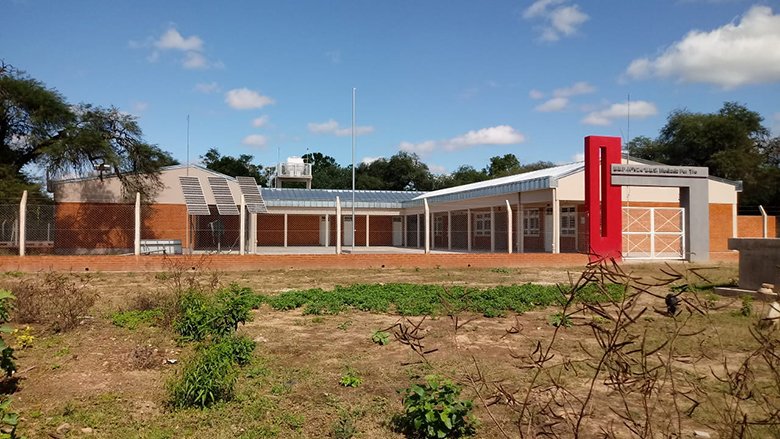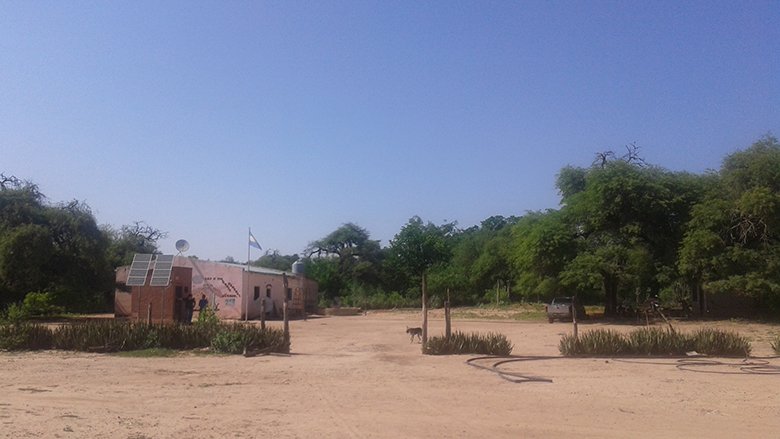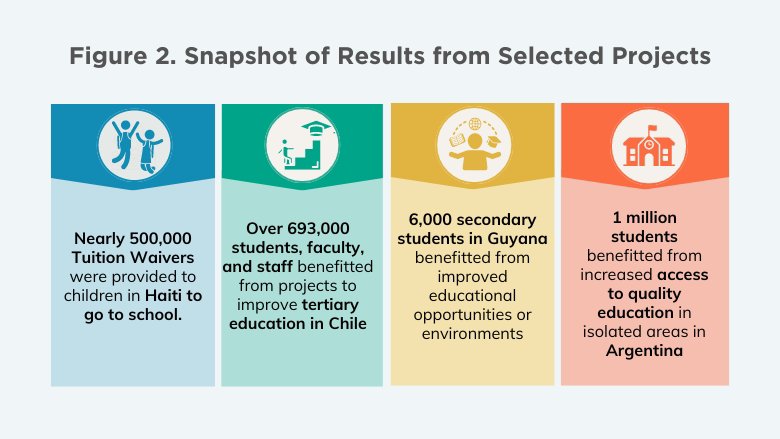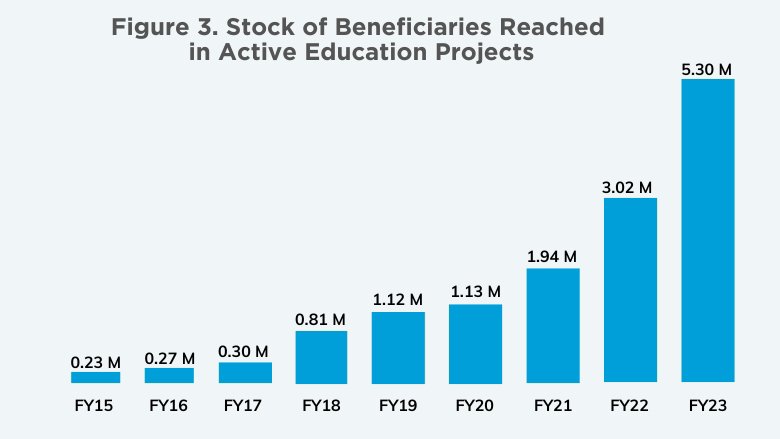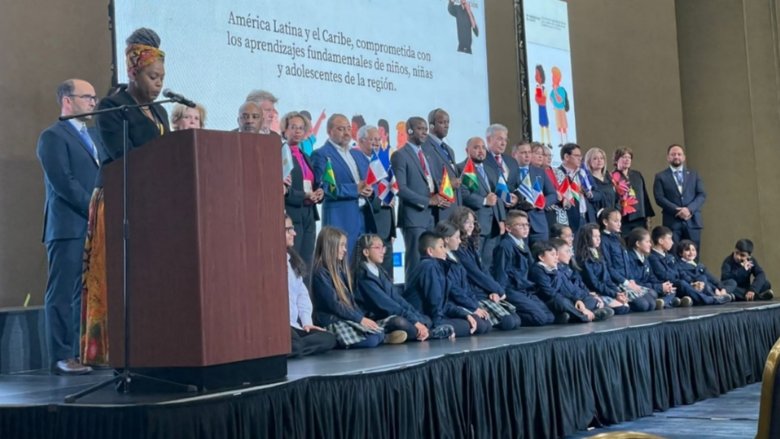Synopsis
The World Bank has played a pivotal role in advancing education in LAC over the past decade. This includes efforts to improve access to education, combat the learning crisis, and improve skills from early childhood to tertiary education. During crises like natural disasters and the prolonged school closures brought on by the COVID-19 pandemic, the World Bank has remained steadfast in its commitment to ensuring educational opportunities for all students, stepping up support and working with governments and partners towards recovering and accelerating learning in the region.
Beneficiary Story/Quote
In rural Argentina, education outcomes have long trailed urban areas. Challenges include poor learning environments with multi-grade teaching, when a teacher must teach children from multiple grades, ages, and abilities in the same classroom. Under the PROMER II project (2014-2021), the World Bank built and upgraded schools and trained teachers and school directors on how to better serve students in rural areas. Lucía Leiva is a school director for a rural primary school in the Department of San Pedro, Province of Misiones. Her school was one of the 183 schools that were reconstructed during the project.
“Thanks to PROMER II, the institution benefitted with significant improvements that directly impacted the quality of the schooling and learning processes, like teacher training received on the methodology for the multigrade teaching-learning process.” Lucía Leiva, School Director, Department of San Pedro, Province of Misiones.[2]
Before and After: School reconstruction in Chaco Province, Argentina
Challenge
Education is vital to drive sustainable, resilient, and inclusive growth in LAC, one of the most unequal regions in the world. Over the past decades, LAC has made great progress in increasing access to schooling: between 1989 and 2019, the out-of-school population went from 1 in 4 children to 1 in 10. Learning levels, however, have not progressed at an equal pace. Before the pandemic, 52 percent of children were experiencing learning poverty, meaning that they were unable to read and understand a simple text.[3] The pandemic exacerbated the situation.
Approximately 170 million children in LAC were deprived of in-person education for roughly one out of two school days between March 2020 and March 2022. As a result, learning poverty may now be much higher than 50 percent, and children in school today risk losing up to 12 percent of their life-time earnings.[4] The most affected are children living in rural areas, those from indigenous communities, and low-income households. Recent data from the Programme for International Student Assessment (PISA) indicate that in 2022, 75 percent of 15-years old students were below basic proficiency level in mathematics and 55 percent below proficiency level in reading, on average in the region. Considering the importance of strengthening foundational skills during the adolescent years for individual success and future employability and earnings in the rapidly changing world of work, and for development more generally, these results are concerning for the future productivity and growth potential of the LAC region.
Approach
The latest World Bank Country Opinion Survey highlights education as a key development priority in the region.[5] The World Bank is responding to demand by increasing support for education with its largest project pipeline ever. The World Bank’s approach to education in LAC derives from a diagnostic of the biggest constraints to reduce poverty and improve education in the region. It has four distinct components (see Figure 1): (i) investing in quality early childhood education and development, (ii) measuring and improving teaching and learning (including prioritizing foundational literacy, improving teaching methods and supporting teachers), (iii) addressing dropouts and improving the skills of secondary and tertiary school age youth, and (iv) pursuing best practices in management, governance, and finance. Underscoring these components is the effective use of information and communication technologies, to provide digital solutions to education, and learning spaces, and enhancing inclusion.
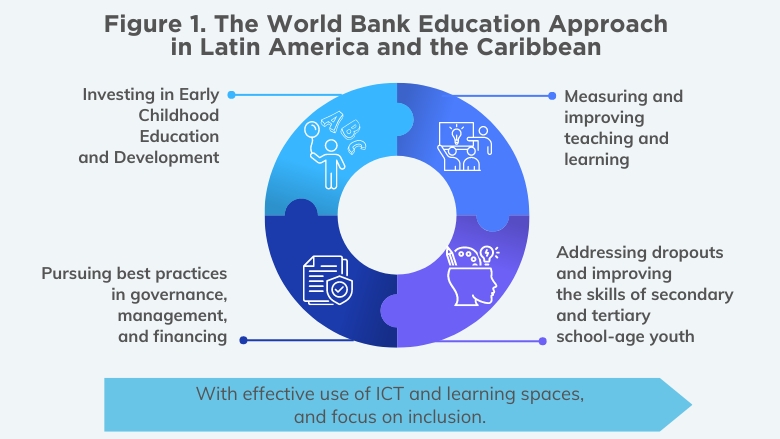
Results
Despite shocks and challenges, the World Bank has successfully supported several countries' advancement in their education and learning goals (see Figure 2 for a snapshot).
The World Bank has supported access to education with improved schooling conditions for students in fragile and conflict situations and small island developing states. In Haiti, despite a challenging context of political instability and recurrent natural disasters, the International Development Association (IDA) helped support access to education and improve schooling conditions. Nearly 80 percent of the country’s primary schools are non-public, and parents have been reported to pay on average $130 each year to send their children to school.[6] Many children from families who cannot pay remain out of school or start school late.
During 2013-2023, IDA and partners provided around half a million tuition waivers to children from low-income families.[7] An IDA-financed school health and nutrition program has benefited a cumulative total of around half a million children, improving access and attendance in 450 schools across the country. Fifty-seven community-based schools were built in remote areas, enrolling about 6,500 students per year between 2011 and 2018. In those years, nearly 27,000 students in 299 schools benefited from instruction through a scripted literacy curriculum with textbooks and teacher guides in Creole – the mother tongue - which have proven in research in other countries to improve reading skills.
In FY2023, the PROMESSE project – including financing from IDA and the Global Partnership for Education (GPE) supported the provision of more than 95,000 textbooks in Créole to students of grades 1-2 in the Southern departments, contributing half the total number of books provided nationally by the Government to students of grades 1-2 in the new initiative to promote mother tongue in early grades. IDA-financing also helped repair 91 schools damaged by Hurricane Matthew in 2016[8] and 22 schools damaged by the 2021 earthquake, and construct semi-permanent structures in 10 schools that were destroyed in Haiti”.
“The Program EFAII helped me pursue my studies. If I did not benefit from it, I do not know where I would be at this time.” 11-year-old Jessica Prudent, who benefited from the Tuition Waiver Program for six years under the Education for All Phase II (EFAII) project in Haiti.[9]
The World Bank engages holistically across the education sector in low-income countries. For example, Guyana boasts the largest education portfolio in the region, featuring three ongoing IDA-financed projects valued at 64 million and 35 million Development Financing Loan. The projects cover all education levels, from nursery to tertiary, in a comprehensive approach for improving education. Thanks to IDA support, Guyana has a new and revised curriculum for nursery and grades 1-9, for which over 1,000 teachers have been trained. As a result, the share of teachers meeting standards for student-centered teaching practices have tripled from a baseline of 7 percent to 22 percent in grades 1 and 2. To support the government's effort in ensuring universal secondary education, the projects have supported school construction and refurbishment. 6,000 students, approximately 10 percent of Guyana’s secondary students, have benefitted from improved educational opportunities and environments.[10]
"The investment in high-quality school infrastructure will benefit many generations of Guyanese students. This is an investment for the future of Guyana," said Saddam Hussain, Guyana's Chief Education Officer at the Ministry of Education
The World Bank has enabled middle-income countries in the region to reduce drop-out and boost learning outcomes and skills. In rural Argentina, the International Bank of Reconstruction and Development (IBRD) increased access to quality education in isolated areas, benefitting nearly 1 million students. The project focused on improving learning environments, through building and upgrading schools and training teachers and school staff and by convening donors like UNICEF to help fill knowledge gaps on rural institutional governance and connectivity in remote areas. 183 schools were built or refurbished. 30,000 teachers, school directors and school supervisors were trained on how to handle pedagogical challenges common in rural areas. Primary education repetition rates in rural areas in the country decreased by almost half, transition rates from primary to secondary education increased from 74 percent to 80 percent, and completion rates for rural upper secondary education increased from 63 percent to 74 percent.[11]
Bank Group Contribution
For the past decade, the World Bank has been at the forefront of addressing the learning crisis in the region. Between FY13-FY23, the World Bank implemented 48 education projects across 19 countries in LAC, totaling $5 billion in commitments. The combined IDA and IBRD annual active portfolio in the region over ten years has been trending steadily upwards. As of February 1st, 2024, the World Bank FY24 portfolio consists of 21 projects in 15 countries, with an estimated amount of $2.6 billion, of which, $2.3 billion comes from IBRD (86 percent), $280 million comes from IDA (10 percent) and $80 million comes from trust funds (3 percent). The typical project size has tripled from $55 million on average in FY13, to $150 million in FY23, and over half of the portfolio is results-based. This trend reflects a strategy of prioritizing larger projects that have a transformational impact. Figure 3 shows the number of beneficiaries reached in active education projects by fiscal year.
One World Bank in Action
Over the past 25 years, the World Bank and the Government of Chile have implemented four projects in the country’s tertiary sector. Over 693,000 students, faculty and administrators have benefitted from these projects.[12] The Tertiary Finance for Results Project III awarded 179 Performance Agreements to tertiary education institutions to enhance the quality and relevance of tertiary education for students. To boost the quality of education provided, full-time faculty members who hold PhDs increased from 5,109 in 2011 to 8,332 at the close of the project in 2016. First-year student retention increased from 68 percent in 2011 to 74 percent in 2016.[13] Santo Tomás is a non-profit higher education institution serving over 89,000 students, mostly from underserved backgrounds, in 22 locations across Chile. Santo Tomás had already accessed several rounds of funding from World Bank projects, when in 2023, IFC approved a loan of USD 50 million to Santo Tomás, to develop new locations, upgrade facilities, build new IT infrastructure, and invest in equipment and technology. Santo Tomás is also receiving ongoing advice from IFC to enhance student employability, drawing on IFC's sector knowledge, as well as their network of clients. This example illustrates how the private sector can help strengthen inclusion and expand access to tertiary education, and help students find quality jobs. It also shows the WBG complementary efforts in this area.[14]
Partners
The World Bank works closely with several education partners in the region. Together with UNICEF, UNESCO, and The Dialogue, the World Bank rolled out an education campaign calling attention to the learning crisis after prolonged school closures, which resulted in a high-level Call for Action supported by Presidents of the region, and an impactful publication (Two Years After), in June 2022. The World Bank also partnered with Colombia’s Ministry of Education, UNICEF, UNESCO, USAID, The Dialogue, and the Inter-American Development Bank (IDB), to co-host a regional meeting to ensure that governments and the education community take action to guarantee that every child of the region acquires basic learning.
Education Ministers and government representatives attended the meeting in Bogota in March 2023, and endorsed the Commitment to Action, which calls for all countries to achieve national targets in foundational learning consistent with decreasing learning poverty levels by 2030. The need to go from “Commitment” to “Action” was reiterated in January 2024 in the high-level ministerial event of Santiago, attended by about 30 country delegations, co-organized by the Chile’s Ministry of Education, UNESCO, The World Bank and other partners. Recently, the World Bank and the IDB teamed up under the “Connected: Digital transformation to accelerate learning” initiative, to pursue a comprehensive approach to the digital transformation of schools in the region, promoting access to connectivity, devices, educational platforms, and digital skills development. IDB and World Bank are coordinating activities to connect 3.5 million students and train more than 265,000 teachers in digital skills.
Looking Ahead
Eight projects, for over $1 billion, have been delivered in FY23 or are currently under development, for what would be the World Bank’s largest year to date in the region. The pipeline is focused on learning acceleration, drawing on the latest findings, and emphasizes foundational and higher-level skills, labor market readiness, learning assessments, resilient learning environments, and technology integration, along with initiatives to reduce dropouts and enhance student support for those falling behind. This increase of World Bank support in the region is an expression of how the World Bank is evolving to become a better and bigger bank.
Learn More
Report: Two Years after : Saving a Generation.
Results Briefs: Education for All in Haiti; Tertiary Education Finance for Results Project III; Argentina’s rural education focuses on higher quality and better learning
Up Front: Guyana: Supporting the Next Generation for Success
Brief: My education, our future
Footnotes:
[1] 21 million people are expected to be reached by the time the projects in the active portfolio close.
[2] World Bank. Results Brief | Argentina’s rural education focuses on higher quality and better learning
[3] World Bank. Two Years after : Saving a Generation. 1 Jan. 2022. Accessed 25 Oct. 2023.
[4] World Bank. Two Years after : Saving a Generation. 1 Jan. 2022. Accessed 25 Oct. 2023.
[5] World Bank Country Opinion Survey. “Context Data.”
[6] World Bank. Results brief |“Education for all in Haiti”. May 6, 2019.
[7] Around 482,000 tuition waivers were provided under the Education for All Phase II project. Some 22,000 were provided under the later Providing an Education of Quality in Haiti project in school year 2018, to allow the last cohort of students to receive the full course of the waiver support from grade 1 to grade 6 to complete their primary schooling. The waivers were then phased out in favor of results-based tuition waiver grants to schools.
[8] World Bank. Results brief |“Education for all in Haiti”.
[9] World Bank. Results brief |“Education for all in Haiti”.
[10] World Bank. Up Front. Guyana: Supporting the Next Generation for Success.
[12] Based on ICRs from The Tertiary Finance for Results Project III, Tertiary Education Finance for Results Project- First Phase APL and the ISR from Strengthening of State Universities in Chile.
[13] https://www.worldbank.org/en/results/2018/02/19/tertiary-education-finance-for-results-project-iii
[14] https://disclosures.ifc.org/project-detail/SII/46778/santo-tomas-2022
